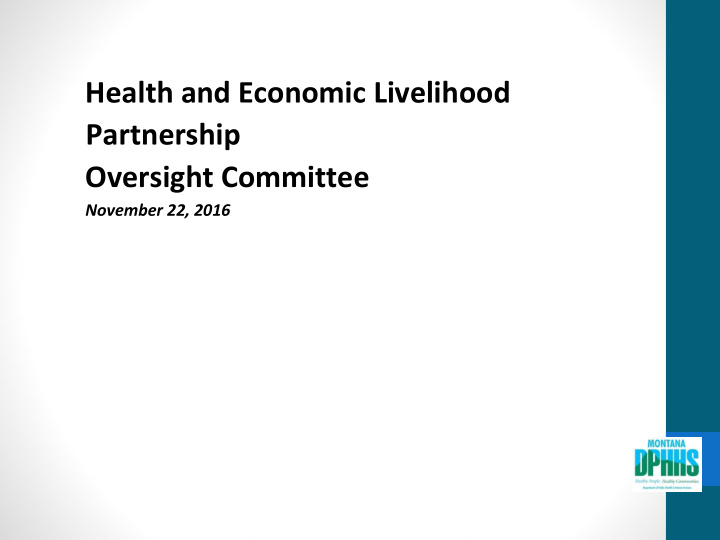



Health and Economic Livelihood Partnership Oversight Committee November 22, 2016
Agenda 1:00 Welcome from the Chair, Introductions 1:05 General Overview – Jessica Rhoades, DPHHS 1:10 Quantitative Data Reports a. DPHHS Data report (15 min) b . Dept. of Labor Data report (25 min) c. Participant engagement report (15 min ) 2:10 Financial Data and Premiums – Marie Mathews, DPHHS 2:25 Administrative Rule Update – Jess Rhoades, DPHHS 2:35 Break Qualitative Topics 2:45 a. Reducing cost shifting – John Goodnow , Chair b . Topics the committee has reviewed to date c. Prioritize topics committee would like to review next 3:15 Medicaid Programs for Reducing Prescription Drug Costs – Dan Peterson, DPHHS 3:25 Public Comment 3:35 Adjourn 2
Meeting Objectives HELP Oversight Committee tasked with discussing: Qualitative Qualitative Financial Administrative Data Data Rules Data May 2015 through June 2019 3
Quantitative Data 4
5
Medicaid expansion member profile 2
Eligibility Before HELP Act 19 - 64 Now, parents and adults without kids living at home between the ages of ) with an income at or below 138% of the Federal Poverty Level (FPL 8 $1,350 a month for one person, and $2,300 a month for a family of three
Montana’s uninsured rate plummeted to from 15 % in 2015 7 % in 2016. 9 Source: Montana Commissioner of Securities and Insurance 2016 Report on Insurance Coverage and Montana’s Uninsured
National Census Data for Veterans P rior to Medicaid expansion Montana had the highest percentage of uninsured veterans in the nation. About 9,000 Montana veterans don’t have adequate coverage. Source: Urban Institute report from May 2012 using data from the U.S. Census American Community 10 Survey ACS ) , an annual survey fielded by the U.S. Census Bureau
Experience from earlier expansion states: National Health Interview Survey Data for Veterans Between 2013 and 2015, the uninsured rate for nonelderly veterans fell by an estimated 42 percent. 2013-2014 drop in uninsured veterans for expansion states 2.9 percentage points versus 2.0 for non-expansion states.
14 % 12 % 12 % 10 % 9 % 8 % 7 % 6 % 4 % 2 % 0 % 2013 2014 2015 Source: National Health Interview Survey. RWJ analysis of national data from the 2011civilian noninstitutionalized population conducted by the Centers for 11 Disease Control and Prevention’s National Center for He– 2015 National Health Interview Survey (NHIalth Statistics (NCHS). S), a survey of the 12
Uninsured Veterans in non - expansion states If Medicaid expansion decisions do not change between now and 2017 , approximately 604,000 veterans will be uninsured in 2017. 21 39 40 Qualify for Exchange Coverage Coverage Gap Earn income above Medicaid or tax credit level
Helping Montanans move up the economic ladder An analysis conducted by the Montana Department of Labor found that 2 / 3 of those eligible for the HELP Act are employed. The HELP Act also offers Montanans new help finding work and help getting new job skills or education. 14
Native American Eligibility & Outreach Jamie Palagi 15
16
Participant Engagement 17
Financial and Premium Report 18
Administrative Rule Update 19
Qualitative Topics Service Incentivizing value and measurable delivery benchmarks TPA options • CPC+ Contractin • PCMH g Process • Health Homes Health Informatio Appropriate use of lab Data Sharing Prescription Dru and diagnostic imaging • HIE Utilization services 20
Increase availability of Reduce cost-shifting and mental health uncompensated services care • Medicaid coverage • Project ECHO Reduce fraudulent billing and Savings Appropriate use of emergency wasteful and department services payment funding for health care 21
Medicaid Programs for Reducing Prescription Drug Costs 22
Innovative Model First State Using Third Party Administrator Model 23
24
Public Comment 25
Thank you https://dphhs.mt.gov/HELPPlan/Policymakers 26
Recommend
More recommend